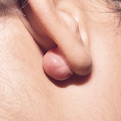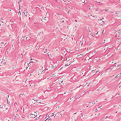Keloid Scar
General Information
Keloids are smooth, shiny, flesh-colored, raised growths of fibrous tissue that form over areas of injury or surgical wounds. Keloids may form in any scar; even scarring that can be results from severe acne. Keloids are asymptomatic, may present tenderness, painful, be pruritic they may also cause a burning sensation. In addition to symptomatic relief, cosmetic concerns are the primary reasons patients seek medical treatment. No single therapeutic modality is best for all keloids. The location, size, and depth of the lesion; the age of the patient; and the past response to treatment determine the type of therapy that will be used by the health-care provider. Prevention is key, but therapeutic treatment of keloids include occlusive dressings, compression therapy, intralesional corticosteroid injections, cryosurgery, excision, radiation therapy, laser therapy, interferon therapy, 5-fluorouracil (5-FU), doxorubicin, bleomycin, verapamil, retinoic acid, imiquimod 5% cream, tamoxifen, tacrolimus, botulinum toxin, and other promising therapies such as transforming growth factor (TGF)–beta3, and recombinant human (rh) interleukin (IL)–10 (rhIL-10), which are directed at decreasing collagen synthesis.
Epidemiology
Prevalence in the black and Hispanic populations can be as high as 16%, approximately 15 times greater in highly pigmented ethnic groups than in whites.
Etiology
Trauma to the skin, both physical (e.g., earlobe piercing, surgery) and pathological (e.g., acne, chickenpox), is the primary cause identified for the development
Pathogenesis
Exaggerated growths of scar tissue, usually in areas of previous trauma.
Clinical
Lesions range from soft and doughy to rubbery and hard. Early lesions are often erythematous. Lesions become brownish red and then pale as they age.
Histology
Collagen fibers in granulation tissue are arranged in a whorled pattern. The nodules demonstrate thick, hyalinized bands in the central portion of the nodule.
Bibliography
1. “Keloid and Hypertrophic Scar” (Online). February 2007 http://www.emedicine.com/DERM/topic205.htm (visited: March 20, 2008) 2. “Keloids And Hypertrophic Scars” (Online).http://www.aocd.org/skin/dermatologic_diseases/keloids_and_hypert.html (visited: March 20, 2008)
Download PDF
![]() Keloid Scar
Keloid Scar


